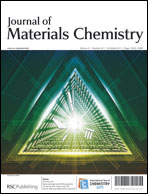Three new tetracyclic 8-hydroxyquinoline derivatives were synthesized by using a Pd catalyzed intramolecular direct arylation reaction in a key step. Furthermore, the new compounds were used as ligands in aluminium complexes and their photophysical properties were studied in detail both in solution and solid state by using absorption, steady-state, and time resolved fluorescence spectroscopies. Results show especially that the aluminium complex of 11H-indolo[3,2-c]quinolin-4-ol has the most blue-shifted emission maximum among the Alq3 derivatives to date and CIE chromaticity coordinates locate on the deep blue area (0.16, 0.12). Moreover, the fluorescence quantum yield of this compound is 3.1–3.5 times higher compared with the parent Alq3. Photophysical properties of the complex did not show major differences between the solution and the solid states. The lack of melting endotherm in DSC analysis indicates that the compound is amorphous. Based on the results, 11H-indolo[3,2-c]quinolin-4-ol has promising features to be applied as a ligand for aluminium or other metal ions in different applications.

You have access to this article
 Please wait while we load your content...
Something went wrong. Try again?
Please wait while we load your content...
Something went wrong. Try again?


 Please wait while we load your content...
Please wait while we load your content...